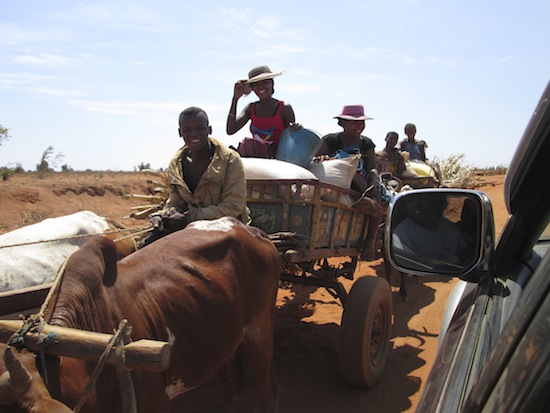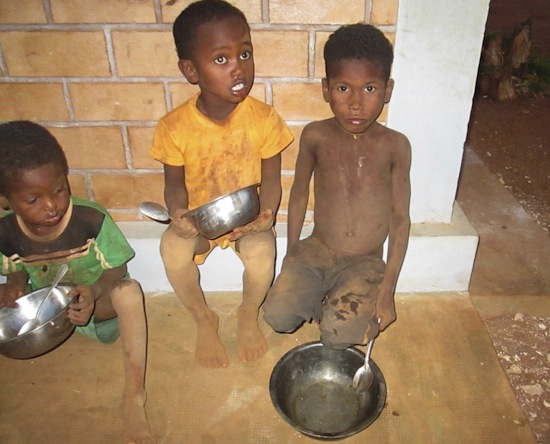 After many days traveling in the central highland towns and villages of Madagascar, it is now time to head to the burning desert heat of the Mikea region with Jonoro and Hanitra and their three beautiful children – 12-year-old Joyce, 10-year-old Johanna and 9 year-old Jonathan. After a few days of preparation, we hit the rutted road to Anjabetrongo, finding the journey as rough and tumble as ever. Along the way we pass villagers traveling on foot, sometimes herding goats or cows, other times carrying heavy loads of this and that. Others struggle through the sand on old bicycles, bounce past in colorful oxcarts or stare blankly through the dirty windows of jam-packed, top-heavy taxibrousses. The intense heat is an issue for everyone, no matter the mode of transportation.
After many days traveling in the central highland towns and villages of Madagascar, it is now time to head to the burning desert heat of the Mikea region with Jonoro and Hanitra and their three beautiful children – 12-year-old Joyce, 10-year-old Johanna and 9 year-old Jonathan. After a few days of preparation, we hit the rutted road to Anjabetrongo, finding the journey as rough and tumble as ever. Along the way we pass villagers traveling on foot, sometimes herding goats or cows, other times carrying heavy loads of this and that. Others struggle through the sand on old bicycles, bounce past in colorful oxcarts or stare blankly through the dirty windows of jam-packed, top-heavy taxibrousses. The intense heat is an issue for everyone, no matter the mode of transportation.
When at last we emerge from the bush and pull into Anjabetrongo, the kids come running from all directions. Jo immediately sets off with large sacks of food to organize meal preparation for the school children. Women from the church will cook for several hours over open fires, so they need to get started. Hanitra quickly organizes the school kids for various activities and we distribute jump ropes and soccer balls, much to the children’s delight. Jo and I wander over to the village pump; I’m excited to finally see water flow in this place, but it’s not to be. The pump is broken and the men are gathered around discussing solutions. They tell us that, because of the extreme depth of the well, it takes the strength of ten grown men to work the pump. But now it’s in pieces and everyone’s thirsty.
Back at the school Hanitra is using the new flannel materials to tell the story of David and Goliath. She’s an engaging storyteller who holds the room captive with her sweeping movements and facial expressions. The kids are also in awe of the colorful flannel graph scenes unfolding in front of them. (So to those who spent countless hours cutting out and organizing these materials, it was well worth it!)
As darkness begins to fall, the children run through the forest to their homes to collect a bowl and spoon for their dinner. Used to being hungry and waiting for food, they sit patiently on the school steps. The older kids gather round me, asking if I remember their names, teaching me Malagasy words and reciting the English equivalent. I can’t help but flash back to the beginning of our work here when everything seemed so other-worldly and we were all strangers. It was hard to imagine back then – when no one could read and no school existed – that a school like this would ever come to be. But here it is – and in a new building constructed with funds donated by a television network in South Korea. Lots of people and organizations are involved here no, but it was definitely different at the start.
 I snap out of my flashback as the women walk toward the school carrying large pots of rice and beans. The children move toward the doorway to listen for their names to be called. They enter the darkened room in an orderly fashion, two at a time, some toting their baby brothers and sisters. Children who don’t attend school lurk in doorways and peek through windows but they don’t go away hungry. Everyone eats and then the children wander back to their homes, their full bellies a stark contrast to their stick-thin arms and legs. They will sleep well tonight.
I snap out of my flashback as the women walk toward the school carrying large pots of rice and beans. The children move toward the doorway to listen for their names to be called. They enter the darkened room in an orderly fashion, two at a time, some toting their baby brothers and sisters. Children who don’t attend school lurk in doorways and peek through windows but they don’t go away hungry. Everyone eats and then the children wander back to their homes, their full bellies a stark contrast to their stick-thin arms and legs. They will sleep well tonight.
The tired cooks eat their dinner and carry the empty pots back to the cooking hut to prepare for tomorrow’s meal. Eventually the night grows still and we lie down together on the bare cement floor to sleep.

